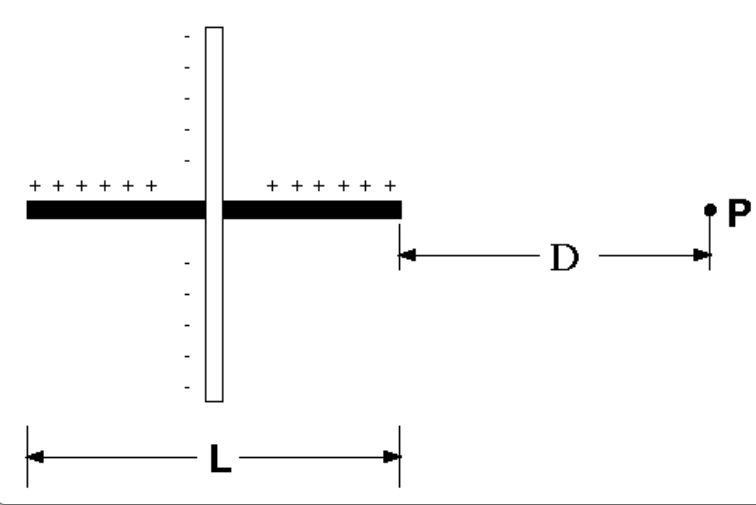Two rods of equal length L=1 m form a symmetric cross. The horizontal rod has a charge of Q=400 C, and the vertical rod has a charge of −Q=−400 C. The charges on both rods are distributed uniformly along their length. Calculate the potential (Vtot) at the point P at a distance D=2.84 m from one end of the horizontal rod. Special note: You're going to have to take the difference between the potentials made by the positive and negative rods, which are similar numbers. That means that to get an accurate answer you need to keep more digits than usual while you're doing your calculation.
Two rods of equal length L=1 m form a symmetric cross. The horizontal rod has a charge of Q=400 C, and the vertical rod has a charge of −Q=−400 C. The charges on both rods are distributed uniformly along their length. Calculate the potential (Vtot) at the point P at a distance D=2.84 m from one end of the horizontal rod. Special note: You're going to have to take the difference between the potentials made by the positive and negative rods, which are similar numbers. That means that to get an accurate answer you need to keep more digits than usual while you're doing your calculation.
Related questions
Question
Two rods of equal length L=1 m form a symmetric cross. The horizontal rod has a charge of Q=400 C, and the vertical rod has a charge of −Q=−400 C. The charges on both rods are distributed uniformly along their length. Calculate the potential (Vtot) at the point P at a distance D=2.84 m from one end of the horizontal rod. Special note: You're going to have to take the difference between the potentials made by the positive and negative rods, which are similar numbers. That means that to get an accurate answer you need to keep more digits than usual while you're doing your calculation.

Transcribed Image Text:+ + + + + +
+ + + + + +
↑P
D -
L-
Expert Solution
This question has been solved!
Explore an expertly crafted, step-by-step solution for a thorough understanding of key concepts.
This is a popular solution!
Trending now
This is a popular solution!
Step by step
Solved in 2 steps
